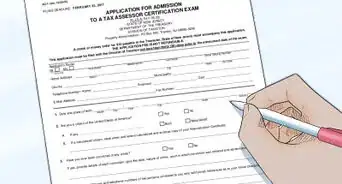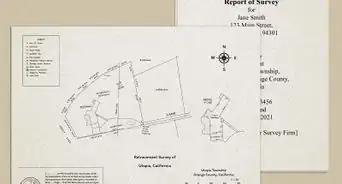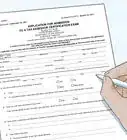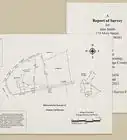This article was co-authored by wikiHow staff writer, Jennifer Mueller, JD. Jennifer Mueller is a wikiHow Content Creator. She specializes in reviewing, fact-checking, and evaluating wikiHow's content to ensure thoroughness and accuracy. Jennifer holds a JD from Indiana University Maurer School of Law in 2006.
There are 9 references cited in this article, which can be found at the bottom of the page.
This article has been viewed 166,230 times.
Learn more...
A land survey describes and maps a parcel of land and all of the buildings or other structures or improvements on that land. If you're buying land, you typically want to get a land survey done beforehand so you know exactly what you're buying. You may also want to find an existing land survey if you plan to make an improvement on your property, such as erecting a fence or expanding a driveway.[1]
Steps
Existing Surveys
-
1Gather information about the property. Finding land surveys may require fairly specific information about the property, such as the street address, a boundary description, or a plat number. The more information you have, the more likely you'll find the survey you need.[2]
- Get information about the township, county, and land range. If you have information about the name of the last surveyor or the date of the survey, this can also be helpful.
- If you have limited information, you potentially will have to sift through a lot of surveys to find the one you need.
-
2Check with your local government online. City or county governments typically keep land surveys. Do a web search for your city or county records or property office. The office's website typically has information about where surveys are kept.[3]
- In some cases, particularly with larger tracts of land, the survey may be kept at the state rather than local level. You may be able to view the actual survey online, since many places digitize these records.
- Even if you can't view the actual survey online, at least you know where the survey is located so you can go to the right office and look at it.
- Some property offices may be willing to mail you a copy of the survey for the cost of postage plus fees for copying.
Advertisement -
3Try a public or land record search site instead. Public records websites may have information about land surveys conducted on the property in question. Some of these sites may charge a fee for their services, or require you to purchase a subscription.[4]
- Property search sites can be easier to navigate than government sites, and they may give you better results if you have limited information.
- On the other hand, if you use a third-party search site you may end up paying for a survey you could have gotten for free if you'd done a little legwork with the local property office.
-
4Visit your local property office in person. If your city or county requires surveys to be filed with the government, you know any existing survey of the property will be at the property records office in the city or county where the property is located.[5]
- Be prepared to provide all the information you have about the property so staff can locate any surveys of that property.
- Often you can look at the land survey for free, but you'll have to pay a fee if you want your own copy. Some records offices also may charge a search fee if you don't have exact information about the property.
-
5Contact the previous surveyor if all else fails. If you have a name and contact information for the person who previously surveyed the property, they probably have a copy of the survey. In most cases, once the work is done the survey itself becomes the legal property of the surveyor.
- When you reach the surveyor, explain that you want a copy of the survey they completed. If they have it, they may charge you to make a copy of it.
New Surveys
-
1Find your official deed. The official deed for the property typically is kept at the county recorder or land records office. Check with your city or county clerk to find out where property records are kept. Typically you'll have to visit the office in person to view the deed.[6]
- You'll need as much information about the property as possible for staff to locate the correct deed. Keep in mind that deeds aren't always organized by street address. You may need a plat number or mortgage description.
- Expect to pay a fee for a copy of the deed. You also may have to pay a fee for the search.
- Property title search companies also may have access to this information. If you're in the process of buying the property, talk to your real estate agent and find out if a title search has been conducted.
-
2Look for survey markers on the property. Different surveyors use different markers to indicate boundaries on land. By walking the land, you may observe stakes, pipes, masonry nails in asphalt, or markings on concrete.[7]
- If you're planning to have a new survey done, these markers can be helpful to your surveyor. Make a note of them so you can point them out.
-
3Get estimates. Before you hire a surveyor, call several offices to find out approximately how much they'll charge to complete the survey. The cost will depend on the size of the land and when the last survey was completed, along with other factors.[8]
- Cost is only one factor to evaluate when you're choosing a surveyor. An experienced surveyor with a good reputation may charge more, but their ultimate product may be worth the higher price.
-
4Hire a licensed surveyor. Most states require land surveyors to maintain a state or national license in good standing. Check your surveyor's licensing and credentials before you hire them. If you're buying a property, your real estate agent may have someone they recommend.
- Most homeowners in the United States spend around $500 to have a land survey completed.[9]
-
5Authorize the survey. You'll sign a contract with the surveyor to hire them to complete the survey. You'll have to provide a reason the survey is being done, such as because you're purchasing the property or building a boundary fence.[10]
- Your surveyor will come to the property and measure it against the legal record. They'll create a map of the property that includes information about the property itself and why the survey was performed.
-
6Request a copy of the survey. Legally, a completed survey belongs to the surveyor. If you hired a surveyor, however, you have the right to a copy of the completed survey for your own records. You also may need to file a copy of the survey with your city or county property office.
Planning a Survey
-
1Find out when the last survey was done. If the last survey on the property was done a long time ago, it's typically a good idea to get a new one done – especially if you're purchasing the property.[11]
- Older surveys may not account for changes in the land, or may include outdated landmarks or structures on the property that no longer exist.
- Generally, get a new survey if the old survey doesn't reflect the condition of the current property.
-
2Talk to your neighbors. Particularly if you're thinking about building a fence or another structure on your property, you may be able to reach an agreement without going to the expense of a survey.[12]
- In the case of a boundary fence, your neighbor may be willing to split the cost of a survey with you as the fence would benefit them as well as you.
-
3Locate underground pipes and cables. Whether you're thinking about building a new structure on the property or want to make some other improvement, you typically need a land survey. This is especially true if the existing survey is several years old, or if it doesn't include information about underground pipes and cables.[13]
- Most surveyors will mark the location of underground pipes and cables. In some cases, you may need to specially request this information.
-
4Talk to a real estate attorney. If you have any questions about an existing land survey, or aren't sure if you need a new one, a licensed and experienced real estate attorney can help you. Some may offer a free initial consultation.[14]
- If you think you're going to hire an attorney, you probably should talk to more than one so you can choose the attorney who best suits your needs and budget. However, you don't need to go to all that effort if you just have a simple question about land surveys.
Community Q&A
-
QuestionI don't know where my property line is, and I want to build a fence. How do I locate my property lines?
 Community AnswerThere should be one in your closing papers from when you purchased the house. If not, you could find one on file at the local courthouse. If they do not have it, you will have to hire a surveyor.
Community AnswerThere should be one in your closing papers from when you purchased the house. If not, you could find one on file at the local courthouse. If they do not have it, you will have to hire a surveyor. -
QuestionHow do I find out if my property has ever had a "pin" survey? This was not a requirement when I purchased the property.
 Community AnswerA "pin" survey simply refers to a survey where physical markers were placed on the property to mark the boundaries. The easiest way to find out if one was done is to walk your property and look for markers. You can also check at your local property records office.
Community AnswerA "pin" survey simply refers to a survey where physical markers were placed on the property to mark the boundaries. The easiest way to find out if one was done is to walk your property and look for markers. You can also check at your local property records office. -
QuestionI don't have any documents related to my grandfather's property, only the street name and current house number. How can I find the survey number?
 Community AnswerGo to your city or county property records office with the information you have and do a search for the original deed. This document will give you more detail about the property that you can use to find any existing surveys of the property.
Community AnswerGo to your city or county property records office with the information you have and do a search for the original deed. This document will give you more detail about the property that you can use to find any existing surveys of the property.
References
- ↑ http://www.plsc.net/docs/pamphlet.pdf
- ↑ http://agriculture.mo.gov/weights/landsurvey/
- ↑ http://agriculture.mo.gov/weights/landsurvey/
- ↑ http://publicrecords.onlinesearches.com/Land-Records-and-Deeds.htm
- ↑ http://www.cityofpeekskill.com/important-info-dates/pages/surveys-deeds
- ↑ http://www.westchesterclerk.com/index.php?option=com_content&view=article&id=68&Itemid=17
- ↑ http://www.co.polk.or.us/pw/hiring-professional-land-surveyor#14
- ↑ http://www.co.polk.or.us/pw/hiring-professional-land-surveyor#14
- ↑ http://www.homeadvisor.com/cost/architects-and-engineers/hire-a-land-surveyor/
- ↑ http://www.plsc.net/docs/pamphlet.pdf
- ↑ http://www.homeadvisor.com/cost/architects-and-engineers/hire-a-land-surveyor/
- ↑ http://www.homeadvisor.com/cost/architects-and-engineers/hire-a-land-surveyor/
- ↑ http://realestate.findlaw.com/neighbors/top-10-reasons-to-have-your-property-surveyed.html
- ↑ http://www.nolo.com/legal-encyclopedia/before-buying-vacant-land-yes-you-need-survey.html
About This Article
Land surveys map out a piece of land and describe all of the buildings and structures on it. To find an existing survey, you’ll need to gather specific information about the property, like the street address or boundary description. Then, visit the local city or county’s website, which may have information about where the survey is kept. You may be able to search online in some cases, but other counties may keep copies of the survey in an office. If you can’t find any record with the local authority, try using a property search site. However, keep in mind that these sites often charge a subscription fee. If you can’t find anything on a property site, try contacting the surveyor who carried out the survey directly, since they may have a copy. For tips on how to get a new land survey, keep reading!










































































